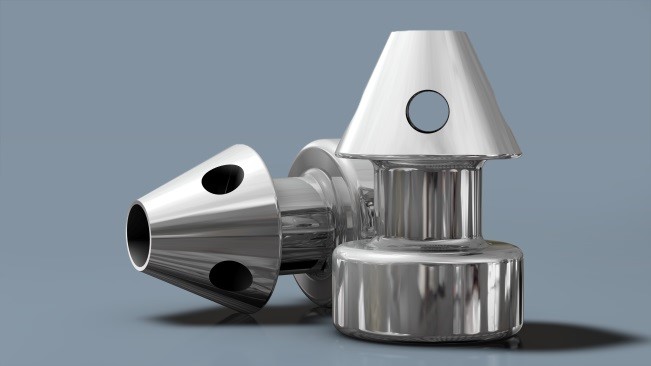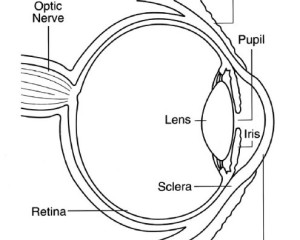If you take medication on a regular basis, it’s very likely that from time to time you will have a ‘whoops’ moment and forget to take your tablets or put in your eyedrops. For some conditions, this is not such a big issue, but for others, the consequences can be quite serious.
The low-down on glaucoma
Glaucoma is a condition in which the pressure of the eye (or ‘intraocular pressure’) is too high, which slowly and silently leads to permanent damage of the optic nerve. This nerve is located at the back of the eye and is responsible for transmitting the images you see to the vision centre in the brain.
If you think of the eye like a digital camera, the optic nerve is like the cord that connects the camera to your computer.
- The optic nerve and its pathway to the brain
- The optic nerve and its position in the eye
When the optic nerve is damaged by glaucoma, it leads to a gradual and permanent loss of peripheral vision. For those who have glaucoma, the most common form of treatment is eye drops. These eyedrops act by reducing the pressure of the eye and therefore helps protect the optic nerve from further damage.
- Normal optic nerve
- Optic nerve with glaucoma
Missed Taking Your Eye Drops?
So what happens when you forget your eyedrops? The pressure in your eye increases. Each time this happens, it causes a little bit more damage to the nerve tissue, and a tiny bit more loss of peripheral vision. As you can imagine, regularly forgetting to put glaucoma drops in can have quite serious consequences and cause a gradual loss of side vision over time.
- An example of vision loss from glaucoma
Forgetting eyedrops isn’t the only risk to eye pressure. If the eyedrop is not correctly instilled into the eye, this also means the medicine will not be as effective.
The Trials & Tribulations of Treatment
Have you ever tried to put an eyedrop in your eye? While the professionals make it look so easy, it can actually be quite challenging. Many people will squeeze too little, too much, or even miss their eye completely. Others may have conditions such as arthritis, which affects their dexterity, and can make squeezing a small bottle in an awkward position quite difficult.
In some cases, more than one eyedrop may be required to control eye pressures, which can also make remembering, and correctly using, the drops even more difficult.
Here’s a fun fact! Some glaucoma eye drops have side effects that many fashionistas would love, such as giving you longer, thicker, darker eyelashes. But there is a downside! They can also cause not-so-pretty side effects, such as stinging, burning, and changes in pigmentation around the eyes. All of these are barriers to using glaucoma drops correctly.
In theory, using eye drops to treat glaucoma and prevent vision loss sounds really simple. However, in reality, it can be quite challenging. Glaucoma is a life-long condition. So for some patients, using these eyedrops correctly every single day, and sometimes multiple times each day is just not realistic.
Many patients who struggle to put their drops in every day, for whatever reason, will often ask about an alternative treatment.
Great news! Introducing the Glaucoma Microstent!
You have most likely heard of stents used in open-heart surgery. These create a bypass for the blood to flow through when there is a blockage preventing drainage.
Glaucoma microstents work in a similar way. Like blood flows through our veins and arteries, we have fluid called ‘aqueous humour’ that flows around the front part of our eye and exits through a type of meshwork in the angle at the front of our eye.
- The flow of aqueous humour
In most people with glaucoma, the aqueous humour has trouble flowing through the meshwork, which results in a build-up of pressure in the eye. The glaucoma microstent allow the aqueous humour fluid to bypass the meshwork through a new pathway. Therefore, they help to lower the pressure of the eye in people with glaucoma by creating a new drainage channel for the aqueous humour to easily flow through.
- Positioning of the glaucoma microstent
These devices are made of titanium and are very tiny, measuring one millimetre by one-third of a millimetre. In fact, they are the smallest prosthetic used in the human body. As you can imagine, this is a micro-surgery that can be technically quite challenging. Currently, these devices are only approved in Australia to be implanted at the same time as cataract surgery.
- The Glaukos iStent – shown to size
Studies have shown that glaucoma microstents have had good results in reducing the eye pressure of people who have mild to moderate levels of vision loss from glaucoma. Another advantage is that they have very minimal side-effects or long-term effects.
Many patients after implantation of a microstent no longer need to use eye drops to treat their glaucoma. Imagine never having to use eyedrops again!
Want to Know More About the Glaucoma Microstent?
Do you have glaucoma? Are you tired of using eye drops every day, and have not yet had cataract surgery? You may like to consider seeking an opinion on whether you may be a suitable candidate for glaucoma microstents.










